Highlights From My Visit to This Year’s Transworld in St. Louis, Missouri
It’s time once again to step into the darkness… This blog is based on episode 29 of my A Scott in the Dark podcast, which I recorded at the granddaddy of the haunt industry—the Transworld show in St. Louis. There was a lot going on for me this year at the show. I arrived in St. Louis, went straight to the convention center, and set up my booth. If you go to the A Scott in the Dark Facebook group, you’ll be able to see photos. I’m trying to put together an edited video, so you should be able to see that as well.
My First Booth at Transworld
My booth was small and not particularly overwhelming, but it did its job. It was a place to sit, hang out, and chat with people. I was very excited. This was the first time I’d ever been on the tradeshow floor before it opened, and it was just as chaotic as you’d think it might be. I did a little bit of a walkaround, and it looked like the show was going to be great. In fact, I’d heard some people say it looked better than it ever had. This was my first time seeing it, and it looked cool to me.
Not only did I have a booth at the show, I was also teaching a seminar on Saturday about putting together an event template you could apply to all four seasons of the year. That way, you could take what you did for Halloween and make it work for Christmas, for summer, and for Spring. It was a great seminar. I was also the host for the Oscares, which is the Haunted Association Awards banquet, so we had a few surprises there. In other words, I was going to be all over the place. So, what I did was, I had a whole bunch of potential interviews lined up, but I wasn’t going to talk about them, because this is a tradeshow and not everything happens the way you want. I also had a few more surprises tucked away.
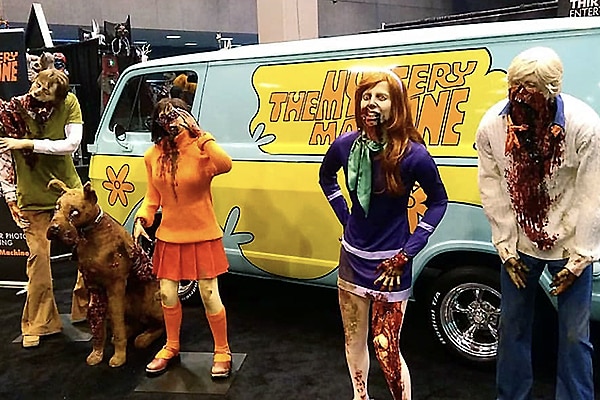
A Chat with Quan Gan about the Next Generation of Z-tag
While I was on the tradeshow floor, I realized I’m the luckiest person in the haunt industry, because I have so many really cool friends. My friend Quan Gan from Z-tech came by and sat at the table in my booth. My first comment to him was, “You kind of disappeared for a while, and now you’re here at the tradeshow. What happened to you?”
Quan replied that he’d only been away for a year, but, for some reason, people thought he’d been gone longer.
I asked him what creepy things he was bringing forth in the show. He replied, “I had to spend about a year to completely refocus on a new venture. I still own Gantom, but, as far as the innovation goes, I’m really channeling it to Z-tech, because I’ve found so much more creativity and potential possibilities in something like this. We can get kids off their couches and interacting face to face. I think there are so many things we can do to create a better, healthier future for the global audience.”
For anyone who’s been living under a rock and doesn’t know what Z-tech is, I asked Quan to explain. “Z-tech is basically laser tag without guns and at close range. In laser tag, you typically have to be hiding and shooting from very far away. We’ve made these smart bands, which we call Z-tags, that everybody wears on their arms, and you can tag somebody as close as three feet. So, it’s a close-up interaction game of tag, but its non-contact,” he said.
“Traditionally, every single kid knows how to play tag. Whenever kids are old enough to start running, they play tag. But sometimes, parents don’t want them to play tag because it’s unsafe, involves physical contact, or could maybe lead to bullying and all that. With Z-tag, we’re using wireless technology to do tag without touching, but it still has the excitement and interaction tag has.”
All this is super cool and, of course, I like it because the “Z” means it has the whole zombie side to it. That’s why the haunt industry is always thrilled by it. When I start seeing new technology like this, my brain just starts going crazy. I start thinking, how can this be applied to haunted attractions?
I knew Quan was doing things with schools now. I asked him to talk more about that. “When you look at schools,” Quan replied, “one of the things they’re really missing now are the PE [physical education] programs. A lot of schools are cutting back on their physical education budgets, and physical activity is one of the most important things kids need these days. For one thing, it stimulates the blood flow through their brains so they learn better. What Z-tag is able to do is gamify behavior. That helps get kids off the couch, onto the playground, and running. For kids that normally don’t want to exercise, when you’re gamifying the behavior of running and tagging each other—we call it Z-tagging—they’re having a lot of fun and don’t know they’re getting a workout. The schools actually love this.”
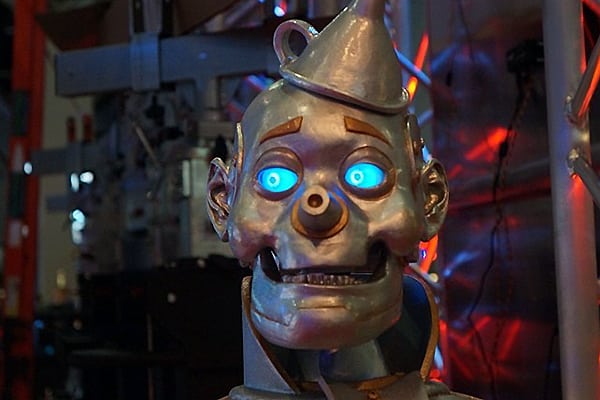
As I continued talking with Quan, I realized we’d gone through these industry buzzwords that are in everyone’s heads. First, everything needed to be “interactive.” Then, everything needed to be “immersive.” Now the big thing is “gamification.” There have been studies done that show the power and impact of gamifying things and making it so that people, in essence, play and don’t realize how much they’re actually accomplishing as they play. It seems like Z-tech ties directly into that.
In its original version, Quan was able to gather a ton of data about Z-tag. I wondered how that helped them to design Z-tag 2.0. Specifically, I wanted to know what they learned from that experience that made the next generation so much better.
Quan was very knowledgeable. “The 1.0 version was our minimal, viable product. Basically, there was a simple little blinking light that indicated whether you were a human, zombie, or doctor. But, there’s very limited information that can be provided by a little blinking light. With Z-tag 2.0, we’ve added a screen to it that gives direct information to the player, so they can see how much health they have, how much strength they have, what class they are, and what their mission objectives are. That basically gives them an interface they’re familiar with that they typically get off their smartphone or off their computer game. In a video game, they get a smart wearable they can see, but now, instead of actually interacting with a screen, they’re interacting with other players, so this is a guest-to-guest experience.”
That’s beyond cool. Z-tag 2.0 should be in everybody’s school, and it should be in every haunted attraction. I can see theme parks doing this across the entire theme park realm, and I can see haunts doing it as a way to move people around in their experience. As I started wrapping up with Quan, I asked if there was one thing everybody needs to know about Z-tag 2.0 and why it can be so impactful.
“I think the main thing is, right now, attractions, in the physical space, are fighting against what kids can do at home or on their smartphones,” he said. “Kids are so engrossed in their screens that it’s a constant struggle of what to provide in your content that can pull them off those devices. At Z-tag, we’re channeling that same energy toward a physical activity. We’re not competing with it, we’re using it. It’s very zen-like, or very yin and yang. We’re using that force and redirecting it, so those kids are spending that energy doing something that’s physically, socially, and mentally positive for them.”
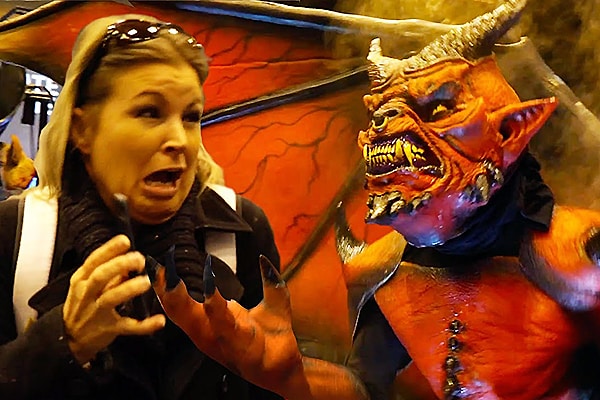
A Reunion Chat with Sharon Agean
I was still on the tradeshow floor, in my booth, and things were real loud, but I was joined by another great friend of mine, Sharon Agean, whom I’ve known for about eighteen years, when we were both working at Busch Gardens parks.
Sharon and I had some catching up to do. “After 22 years, I left the theme park industry in September, 2018 and went back to traditional theater and dance in a stand-alone, presenting performer arts center in Orlando, Florida, the Dr. Phillips Center for the Performing Arts,” Sharon told me. “I think back to that time when we worked together and the vendors you had to choose from to purchase costumes or masks or prosthetics or makeup or anything else in the haunt industry. You could count on one hand the vendors that were doing masks or the vendors that were doing animatronics or fog options. Now, the number of suppliers in our industry is amazing. We have theme parks and standalone attractions that are making this business thrive, and we have haunt enthusiasts who are keeping it thriving. It’s amazing to me there are so many vendors now that are offering products and services. It’s good to see a little more competition among the vendors. We, as buyers, have more choices.”
I had to agree—things have changed a lot. There are so many more vendors in the haunted attractions space. I asked Sharon about the name of the seminar she gave earlier that day on entertainment options for Christmas events.
“The title was ‘Rocking Around the Christmas Tree,’ and it was focused on creating show product to enhance your attraction, your event, whatever it is you’re doing, and whether you want a main-stage show or atmospheric entertainment. First off, I focused on ‘What’s your why?’ Why are you doing it? What are your goals and objectives? Do you need an anchor show that helps extend the length-of-stay? Do you want a show that’s a hook and will keep people around? Do you only offer a show once a night, or do you have a two-hour wait for Santa and want atmospheric entertainment to entertain the folks in line? My focus was on the goals, the objectives, the why, who’s your demographic, and what’s your competition. Competition is so relevant, so important. Not only for you to get out and benchmark what’s going on around your town, but also to understand what they’re doing. If you want a standalone attraction, don’t do what that guy five miles down the road is doing.”
I then asked Sharon if she could talk about what she’s doing on the creative side.
“I’ve decided to take a leap of faith—wherever it may take me—and start freelancing. I’ve had people ask me, ‘What are you going to do? What are you going to focus on?’ Over my 22 years at the theme park, as you know, I wore many hats, as many people in the theme-park industry do. You start to get pretty good at wearing a lot of different hats. I really enjoy being a show producer, I enjoy being a project manager, and I enjoy being a process improver. I enjoy walking into a place that might be established but something’s a little wrong. They’re not sure what it is, or there’s opportunity for improvement, so I do a root-cause analysis and dissect it. I say, ‘You’re trying to get to XYZ, but let’s figure out what’s happening in ABC first. How do we get there?’ Also, I like being a part of creative brainstorming, or even being a facilitator for creative brainstorming, because sometimes people are well intended and great ideas, but they don’t know how to get there. Having the right facilitator in the room helps people get things to where they need to be. It’s kind of like a whole soup-to-nuts experience.”
I knew exactly what Sharon was talking about. Please check out the new work of my friend Sharon Agean at [email protected].
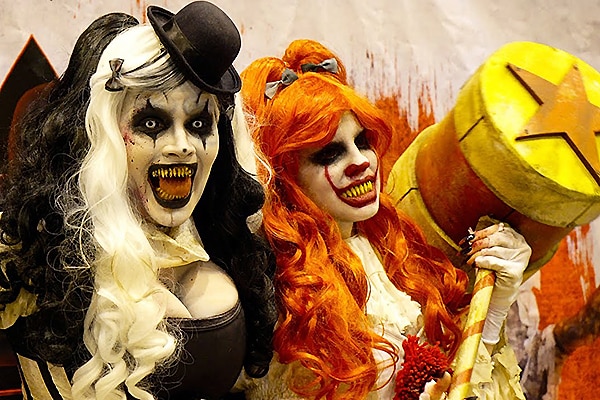
Drew and I Do a Simultaneous Podcast
This next segment was again recorded on the tradeshow floor for The Big Scary Show with Drew Badger. The Big Scary Show, of course, is another phenomenal podcast, one that’s been around a lot longer than I have. Drew is in St. Louis. Below are some of the highlights of Drew interviewing yours truly for The Big Scary Show.
Drew first asked me what I’d been up to and how I found myself at the Transworld show.
I told him I was at the Transworld show for the very first time as a vendor. I’d attended for 19 years in a row but never as a vendor. “Since I’ve become an independent contractor and started my own company, a lot has happened, and a lot has changed. I’m now in a position where I can start reinvesting into my own company. I’ve been successful enough, and I’m confident enough that I’m continuing to pick up new clients and move forward. So, I decided, ‘Let’s invest the time and energy it takes to have a booth at pretty much any show.’ Then I figured, if I’m going to do any show, let’s do the granddaddy of them all,” I explained.
“As luck would have it, I happened to be invited to speak at this show as well, so I figured, if I’m going to be here anyway, I might as well reinvest in myself. So, here in my booth, I’ve met a bunch of new clients, I’ve reconnected with some old clients, and I feel I’ve been very lucky. The show has paid for itself. To be honest, I had no idea if it was going to be a good move or just a money pig. The truth is, right now, I’d say it was a good move.”
Drew asked me what I do for my clients.
“That’s not an uncommon question,” I told him. “Scott Swenson Creative Development is intentionally vague because I write, direct, and produce—it just depends on what my clients need. If they need somebody to write a script for their haunted attraction, or what I call a venue flow, I can do that. If they need me to cast and train their actors, I can do that. If they need me to produce the whole show, I can do that. Because of my background, I’ve had the opportunity to participate in pretty much every level of the entertainment industry—everything from performer to executive producer. Now I just take projects I like, and I make those work.”
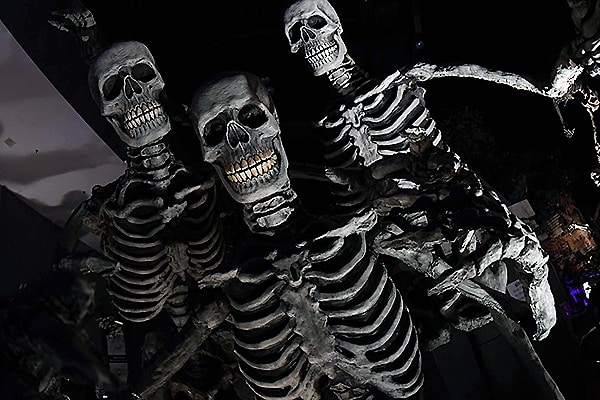
Drew asked, “Let’s say I own a haunt, we do okay for a few years, and we’re wondering how to take it up to the next level. We find you here and we ask you, ‘What can you do for us?’ What might be your response?”
“There’s a spectrum of things I could do for you as an independent haunt. The first thing I’d suggest is to hire me to come out and do a product evaluation. I’ll make a visit to your haunt, after signing a non-disclosure agreement, which means I won’t take any of your ideas—they remain with you. I’ll come out and, using my 30+ years of experience in all these different levels of the haunt industry, I’ll apply them to what you want to improve. Do you want to improve attendance, do you want to improve revenue, do you want to improve quality? I’ll then present you with a report and, based on that report, you can choose to continue with me, and I can write the next iteration of your script or venue flow. That’s great. Or, you can take my report and handle the rest of it on your own. I’m completely fine with that as well. If you want to take my report and hire somebody else to do it, I’m golden with that also. I can do as much or as little as my clients need,” I explained.
“For example, Fort Edmonton Park in Fort Edmonton, Alberta, brought me on as the creative director for a project that ended up being called Dark. I wrote it, I sat in on the budget meetings, I helped them create not only the labor budget but also the props, scenic, and costume budget. I was involved with casting, I helped them train their actors and stage managers, and then I did an evaluation of the event on its opening night. They had me from the beginning through opening, which I’m totally comfortable with. I love that. Some of my other clients have hired me to just do the casting and training of their actors, and other clients have just bought a script from me. So, it’s all about right sizing what the client needs and then right sizing the agreement between me and the client to make certain we both feel we got a good deal.”
I added this in response to Drew’s question: “If your haunt or event is making exactly what you want to make financially, and you’re creating the quality product you want to create, there’s nothing I can do for you. But, if you want to get better, if you want to make more money, if you feel there’s something wrong with your haunt or event, that’s what I’m here to do. I’ve had two clients come up to me during this show and say, ‘We’re doing okay, but we’re not at the level we’d like to be, and we don’t know how to get there.’ Well, the best way to get there is to bring somebody in who has experience, who’s working for you and not against you, and hear what they have to say. That information is worth money. A lot of people think, ‘What am I paying you for, really? Am I just paying you to look at my stuff and talk about it?’ No. When I evaluate anything entertainment-based, especially haunts, I evaluate them from the guest’s standpoint and the story you’re trying to tell impacts the guest. Story always comes first and, in fact, when you go to my website, ScottSwenson.com, the first thing you see is, ‘Scott Swenson is a storyteller.’ That’s what I do. I’ve done that for theme parks, I’ve done that in print, I’ve done that for independent haunts, I’ve done it all over the place. I continue to find ways to tell new stories and tell other people’s stories. I’m a consultant and, if you need me to help tell your story, I’m just as comfortable doing that as I am having you come to me and say, ‘I don’t have a story, but I need one. Can you help me with that?’ I can start from nothing, or I can start from everything.”

Final Reflections
So, those are some of the highlights of the Transworld show for 2019. It had been a very long and, in some ways, grueling show, but it had been remarkably enlightening—and, hopefully soon –profitable. I know it was profitable from a conceptual standpoint and from a connection standpoint.
The one thing that comes through every time I go to one of these shows is that we’re a group of people who are very passionate about what we do, and the way to make us all better is to continue to support one another. I can’t even count how many times throughout the course of the four days of Transworld that haunters gathered around—whether in my booth or after the tradeshow floor events or even right after my seminar. We’d gather together and talk about the industry, share thoughts, and share ideas. This can only make us all better. I truly believe that’s the real value of what these shows have to offer—a place for likeminded people to come together, share their thoughts, share their best practices, and help each other solve their problems. The more we can do that, the better we’ll be able to help ourselves as an industry.
This was especially obvious to me when I was lucky enough this year to be the host for the Haunted Attraction Association awards banquet called the Oscares. This is something the HAA does and, by the way, if you’re not a member of the Haunted Attraction Association and you’re in a haunt, you should definitely consider it. What they basically do is they help us evaluate ourselves as an industry. They offer safety and training seminars, they recognize excellence within the industry, and, starting in 2020, they’ll be offering not two but three different scholarships to young people who are involved in haunts, going off to college, and need a little extra funding. The nice thing is these are sponsored scholarships, so they don’t use any of the membership dues to cover them or fund them.
Another thing the HAA does that I think is great is they work from a PR standpoint in defense of or to promote the haunt industry when it needs defending or promoting. Much of this money comes from the annual auction they do right here at the Transworld show. This year, the HAA raised over $23,000 at their auction, and that was thanks to generous donations from so many vendors, especially the ones here at the Transworld show. So, it’s just a great organization to belong to, and they really help us out as haunters and as independent contractors like myself.
In hosting that awards show, it was great to see everybody come together to applaud the excellence of what, in other industries, would be considered “the competition.” When a specific haunt or a specific vendor received an award, the members of that team were probably the loudest in the room. That’s true. Nobody raised an eyebrow and said, “Oh, I can’t believe so-and-so got an award and I didn’t.” They were all supportive and very excited. If you check it out on social media, you’ll see photos of all the people who won.
The HAA also gives out a Lifetime Achievement Award each year. Last year, my dear friend—and the dear friend to so many people in the haunt community—Robbi Lepre, had the opportunity to receive the Lifetime Achievement Award. This year, it went to the gentleman who founded the haunt at Knott’s Berry Farm—the oldest theme-park haunt in the industry. He, unfortunately, was unable to be there, but he did a wonderful and quite funny acceptance speech via video. So, it was just a great evening.
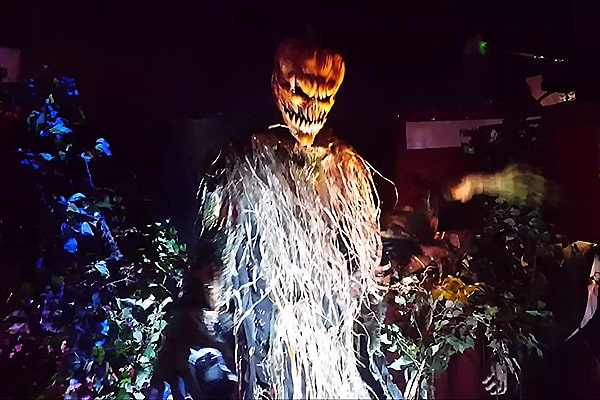
I also got to hang out with, as you’ve heard, my friends Sharon, Quan, and Badger. It’s such a great opportunity for us to get the entire industry together in one place at least once a year, and St. Louis is such a gracious city. Even the Uber drivers I had to and from the convention center were asking, “Hey, what’s this convention all about?” When I was leaving for the airport, my poor Uber driver, who’s originally from Haiti, was completely freaked out by all the monsters and wretchedness that was going on out back of the convention center. He was creeped out and said, “Oh my gosh, I’m going to have nightmares tonight.”
I also had a chance to hang out with my friends from Epic Entertainment Group, although, unfortunately, I didn’t have a chance to record anything. They host a remarkably wonderful, invite-only, cocktail party that I’ve been lucky enough to be invited to for the last two years. It takes place on the top floor of the Hilton—I think it’s the Hilton—in a restaurant called 360, which, as the name suggests, has a 360-degree view of downtown St. Louis. At that party, I got to meet people I’d never met but probably should have. One of them was a lighting designer, Chris Werner. We’d talked to a lot of the same people, knew a lot of the same people, and our paths had crossed many times, so the fact we’d never met each other was ridiculous. We got to chat and catch up on the people we knew and all that sort of thing.
I also had the rare opportunity to meet some folks from Knott’s Berry Farm. Back in the day, when I was working for Busch Gardens and we were creating Howl-O-Scream for the first time, we went to Knott’s Berry Farm to study their Halloween haunt, which, of course, is the granddaddy of them all. We based a lot of the business model for Howl-O-Scream at the time on what Knott’s Berry Farm was doing. They were basically a family-friendly park that, at night, turned into something wretched and creepy. At the Epic Entertainment Group Party, I got to chatting with some folks from Knott’s Berry Farm, and they said to me, “You know, we used to come to your event, were inspired by it, and we tried to apply the best practices we saw at Howl-O-Scream to Knott’s Halloween haunt.” I said, “Wait a minute, wait a minute. You inspired us!” So, that’s a perfect example of how inspiration can beget inspiration.
I’d like to end by saying that I’m really glad so many people on our Facebook group commented and gave me new ideas for the next Listener’s Choice episode. It’s so exciting for me that this Facebook group is taking on a life of its own. You guys aren’t only looking out for me and the show but for each other. This is creating another community within our community of haunters. So, I really appreciate that and hope it continues.
I promise you there will be another Listener’s Choice with questions from the group, because I’ve got a bunch of things I want to talk about very, very soon. If you’d like to ask questions, suggest topics, or even make comments on what I’ve said or written on any podcast or blog, show, please go to our Facebook group, go to AScottInTheDark.com or my website, or email me at [email protected]. Until next time, rest in peace